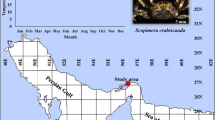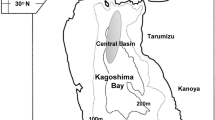Abstract
Cryptodromia hilgendorfi de Mann 1888 is an intertidal sponge crab that uses sponges and ascidians as places to live and for concealment. Most crabs occur alone on sponges, but when the tide is in, there are frequent movements. The crab is a biennial species with a maximum life span of approximately 2–5 yr. Generations overlap by 1.5 yr and during early summer as many as 3 generations may occur together in the same area. Both males and females live to approximately the same age and females are iteroparous, producing an average of 3–4 broods in a lifetime (maximum 6–7). Females moult after each brood and must remate in order to produce fertile eggs. Eggs (mean diameter 0.73 mm) are carried from September to February and recruitment occurs during December to March. The young are not brooded by the female and have a planktonic phase lasting 2–3 wk. Brood size increases with age from 150 eggs for the first brood to over 600 eggs for the largest females. Average lifetime production of offspring is approximately 1 500 (maximum 3 600). The largest contribution to recruitment comes from first brood offspring. Compared to other Brachyura of similar size C. hilgendorfi produces smaller broods composed of larger eggs. Life table analysis suggests that reproduction is more than sufficient to achieve replacement. The young crabs have a specific settling response to the sponge Suberites carnosus. Sex ratio at settling does not differ from 50/50, but as a result of differential growth and perhaps differential mortality, females predominate in the larger size classes. Both males and females have indeterminate growth but their parabolic growth curves differ. Females grow more rapidly so that males of the same age are smaller. Moult increments and intermoult intervals differ between the sexes. Male increments are smaller and independent of initial size whereas female increments are larger but decrease with increasing size. Intermoult intervals for males tend to be longer than for females although female intervals increase more rapidly as the crab grows. Sexual size dimorphism differs from the typical brachyuran pattern of males being larger than females.
Similar content being viewed by others
Literature Cited
Andersson, M. and R. A. Norberg: Evolution of reversed sexual size dimorphism and role partitioning among predatory birds, with a size scaling of flight performance. Biol. J. Linn. Soc. 15, 105–130 (1981)
Bennett, D. B.: Growth of the edible crab (Cancer pagurus L.) off southwest England. J. mar. biol. Ass. U.K. 54, 803–823 (1974)
Bliss, D. F. and J. R. Boyer: Environmental regulation of growth in the Decapod crustacean Gecarcinus lateralis. Gen. comp. Endocrinol. 4, 15–41 (1964)
Butler, T. H.: Growth and age determination of the Pacific edible crab Cancer magister Dana. J. Fish. Res. Bd Can. 18, 873–889 (1961)
Campbell, B. M. and W. Stephenson: The sublittoral Brachyura (Crustacea: Decapoda) of Moreton Bay. Mem. Old. Mus. 15, 235–301 (1970)
Diaz, H.: The mole crab Emerita talpoida (Say): a case of changing life history pattern. Ecol. Monogr. 50, 437–456 (1980)
Green, G.: Ecology of toxicity in marine sponges. Mar. Biol. 40, 207–215 (1977)
Hale, H. M.: The development of two Australian sponge-crabs. Proc. Linn. Soc. N.S.W. 50, 405–413 (1925)
Hancock, D. A. and E. Edwards: Estimation of annual growth in the edible crab (Cancer pagurus L.). J. Cons., Cons. Explor. Mer 31, 246–264 (1967)
Hartnoll, R. G.: Notes on the marine grapsid crabs of Jamaica. Proc. Linn. Soc. London 176, 113–147 (1965)
Hartnoll, R. G.: Copulatory structure and function in the Dromiacea, and their bearing on the evolution of the Brachyura. Publ. St. Zool. Napoli 39 Suppl., 657–676 (1975)
Hartnoll, R. G.: The effect of salinity and temperature on the post-larval growth of the crab Rithropanopeus harrisii In: Physiology and behaviour of marine organisms, 388 pp. Ed. by D. S. McClusky and A. J. Berry. 12th European Symp. on Mar. Biol. New York: Pergamon Press 1978
Hartnoll, R. G.: Strategies of crustacean growth. In: Biology of Crustacea. Ed. by L. Abel. New York: Academic Press (In press)
Jones, M. B.: Aspects of the biology of the big-handed crab, Heterozius rotundifrons (Decapoda: Brachyura), from Kaikoura, New Zealand. N.Z. J. Zool. 5, 783–794 (1978)
Jones, M. B.: Reproductive ecology of the estuarine burrowing mud crab Helice crassa (Grapsidae). Estuar. coast. mar. Sci. 11, 433–443 (1980)
Kirkman, H.: Standing stock, ecology and decline of seagrasses at Toorbul Point, Moreton Bay, Queensland, 150 pp. Unpublished M. Sc. thesis, University of Queensland 1976
MacKay, D. C. G. and F. W. Weymouth: The growth of the Pacific edible crab, Cancer magister Dana. J. Biol. Bd Can. 1, 191–212 (1935)
McLay, C. L.: The dispersal and use of sponges and ascidians for camouflage by Cryptodromia hilgendorfi (Brachyura: Dromidea) (In preparation)
Passano, L. M.: Moulting and its control. In: The physiology of Crustacea, Vol I, pp 473–536. Ed. by T. H. Waterman. New York: Academic Press 1960
Reilly, P. N. and S. B. Saila: Biology and ecology of the rock crab, Cancer irroratus Say, 1817, in southern New England waters (Decapoda, Brachyura). Crustaceana 34, 121–140 (1978)
Rice, A. L. and A. J. Provenzano, Jr.: The larval development of the West Indian sponge crab Dromidia antillensis (Decapoda: Dromiidae). J. Zool. Lond. 149, 297–319 (1966)
Simons, M. J. and M. B. Jones: Population and reproductive biology of the mud crab, Macrophthalmus hirtipes (Jacquinot, 1853) (Ocypodidae), from marine and estuarine habitats. J. nat. Hist. 15, 981–994 (1981)
Swartz, R. C.: Reproductive and molt cycles in the xanthid crab Neopanope sayi (Smith, 1869). Crustaceana 34, 15–32 (1978)
Warner, G. F.: The Biology of crabs, 202 pp. London: Elek Science 1977
Author information
Authors and Affiliations
Additional information
Communicated by G. F. Humphrey, Sydney
Rights and permissions
About this article
Cite this article
McLay, C.L. Population biology of the sponge crab Cryptodromia hilgendorfi (Dromiacea) in Moreton Bay, Queensland, Australia. Mar. Biol. 70, 317–326 (1982). https://doi.org/10.1007/BF00396850
Accepted:
Issue Date:
DOI: https://doi.org/10.1007/BF00396850




